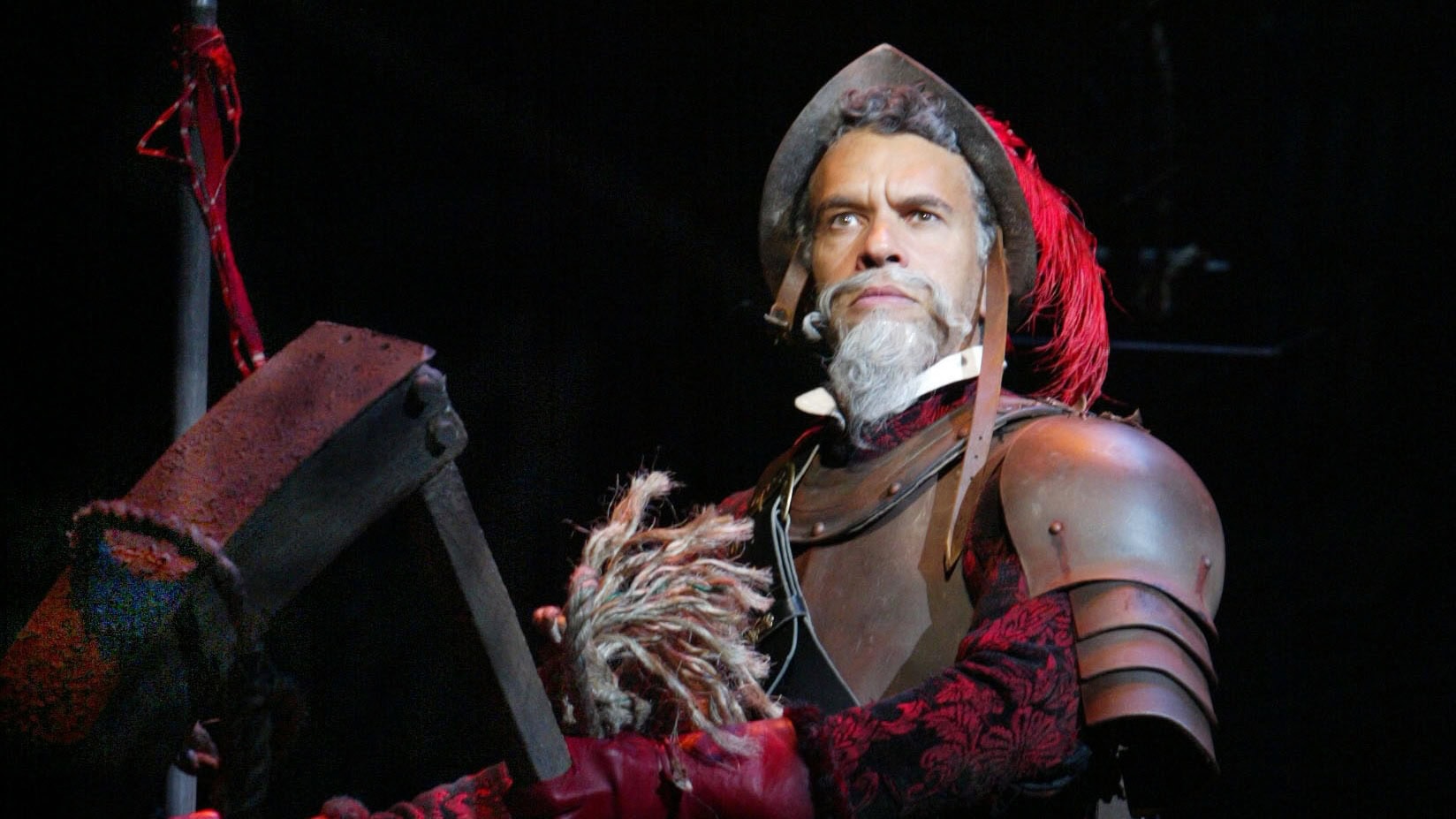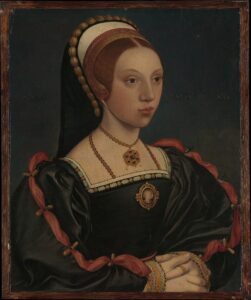
Catherine of Aragon
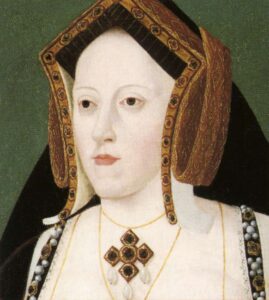
In the show:
Catherine and Henry had a tumultuous relationship, mostly because she did not bear him a son. In “No Way,’” Catherine sings about her loyalty to the Roman Catholic Church. Though Catherine and Henry’s relationship was out of control, it lasted 24 years. She fought an annulment and his threat to move her into a nunnery… she wouldn’t back down.
In real life:
Catherine of Aragon (1485-1536), youngest daughter of Isabella and Ferdinand of Spain, was indeed married to Henry for 24 years, from 1509 to 1533. She had previously been married to Henry’s older brother, Arthur Prince of Wales (1486-1502). They were wed in November 1501, when Catherine was 15 and Arthur was just 13. The marriage lasted less than a year; Arthur died of an unknown illness in April 1502. Catherine and Henry were wed in 1509. In 1533, after 24 years of marriage, Henry sought an annulment, claiming that Catherine’s previous marriage to his brother rendered their union invalid. Catherine’s fertility problems – specifically, her inability to give Henry the son he so desperately wanted – also led to the dissolution of their marriage. It is believed, however, that Catherine was Henry’s true love, and just before her death, no longer a Queen, she forgave him for his poor treatment.
Anne Boleyn
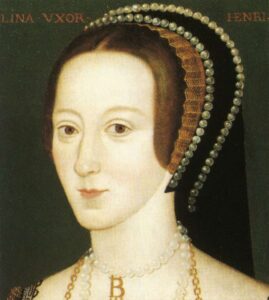
In the show:
Anne is flippant and self-centered, a party girl who knows nothing about politics. In “Don’t Lose Ur Head, ” she recounts her brief and tumultuous relationship with – and marriage to – Henry. Dismissive of the other Queens, Anne brags about convincing Henry to break from the Roman Catholic Church to establish the Church of England.
In real life:
Anne Boleyn (1501 or 1507-1536), daughter of Thomas Boleyn and Elizabeth Howard, was an English noblewoman educated in France. Henry courted Anne while he was still married to Catherine of Aragon, but Anne refused to become Henry’s mistress. After a secret wedding on in November 1532, Henry and Anne formally married on January 25, 1533. The Roman Catholic Church, which did not recognize divorce, refused to grant Henry an annulment of his first marriage, so Henry left the R.C. Church for the Church of England, naming himself Supreme Head. Though Anne gave birth to the future Queen Elizabeth I, she had three subsequent miscarriages and never bore a son. Desperate for an heir, Henry had Anne investigated for high treason in April 1536, and she was executed by beheading in 1536.
Jane Seymour
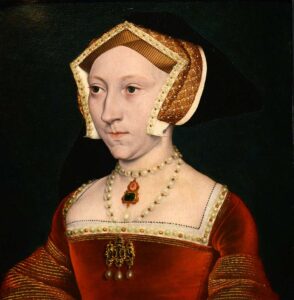
In the show:
Jane is the wife who finally gives Henry a son. This joyous event surges through “Heart of Stone,” the show-stopping solo that Jane sings in SIX. Unfortunately, Jane dies weeks after giving birth to this male heir. Jane recognized all of Henry’s indiscretions but remained loyal to him. She truly loved him and stood by his side.
In real life:
In contrast to Henry’s first two wives, Jane Seymour (1508-1537) had a timid and understated personality. Reportedly, this was a big part of Henry’s attraction to her. Jane married Henry in May 1536, and bore him a son, the future King Edward VI, on October 12, 1537. The birth was difficult, and she died 12 days later, on October 24, 1537. Henry was distraught upon her death; Jane’s status as the mother of his son put her on a pedestal. She is the only one of Henry’s wives to be buried alongside him; they are interred side by side in St George’s Chapel, Windsor Castle.
Anne of Cleves

In the show:
Anne is brazen, bold and confident – pleased with her outcome, she has no interest in playing the victim. In Germany, artist Hans Holbein painted Anne’s portrait, touching it up to make her look traditionally beautiful. When Henry first saw the painting, he was enchanted. But when Anne was summoned to England, Henry was repulsed by her. Claiming that the portrait was a fake, Henry sought an annulment, sending her to live in a palace in Richmond. Now free of Henry and the burdens of being queen, Anne is unbothered and determined to live her best life.
In real life:
Anne of Cleves (1515-1587) was the daughter of John III of the House of La Marck, often referred to as the Duke of Cleves. Anne’s marriage to Henry lasted just six months, from January 1540 to July 1540, at which time the marriage was annulled, purportedly because their marriage was never consummated. Anne outlived all of Henry’s wives and lived to see his children coronated. Since she did not contest the annulment, Anne was treated very generously by the crown. Upon her death, Anne was buried in Westminster Abbey, as she had requested.
Katherine Howard
In the show:
Katherine, spelled with a “K” in the musical, brutally recounts her experience with men who took advantage of her, including music teacher Henry Mannox, secretary Francis Dereham and courtier Thomas Culpeper. When she meets Henry, Katherine hopes things will be different, but he is no better than the others. Their tumultuous relationship leads to her being beheaded for treason.
In real life:
Catherine Howard (1523-1542), spelled with a “C” in most historical documents, was the daughter of Lord Edmund Howard and Joyce Culpeper, and a cousin to Anne Boleyn. A former maid-of-honour to Anne of Cleves, she was about 17 years old when she married Henry VIII in July 1540. Early in their marriage, Henry was overcome with love and excitement. His generosity to her was overwhelming – he couldn’t give her enough, until signs of Katherine’s infidelity begin to surface. In 1542, at age 19 or thereabouts, Catherine was executed by beheading.
Catherine Parr
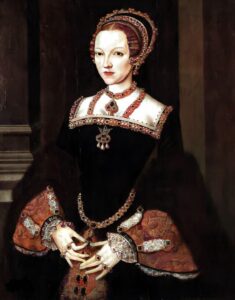
In the show:
Catherine points out that, like Henry, she had been married before. Her previous husbands both died, and each time she sought a new spouse. In “I Don’t Need Your Love,” she explains that she broke off a relationship with a man named Thomas, feeling obligated to marry Henry instead. She proudly mentions writing about female independence and confidently declares herself the “final wife.”
In real life:
Catherine Parr (1512-1548), eldest child of Sir Thomas Parr, lord of the manor of Kendal in Westmorland and Maud Green, was was the final queen consort of the House of Tudor, outliving Henry by a year and eight months. She had the most calming influence on Henry’s world. She took pride in being the stepmother of his children, Mary, Elizabeth and Edward. She had a warm heart and espoused the value of education. She was a published author; her first book, Prayers or Meditations, published in 1545, was the first original book published by an English queen under her own name. After Henry’s death, Catherine remarried, giving birth to her only child, Mary Seymour, on August 30, 1548. Catherine died as a result of the birth a few days later, on September 5, 1548. Her funeral was the first Protestant funeral in England, Scotland or Ireland to be conducted in English.
Henry VIII
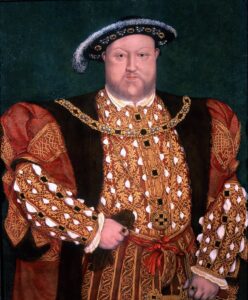
In the show:
Henry doesn’t appear in the show but does serve as the thread tying together the stories of his six wives. All of the musical’s references to Henry create the picture of a powerful, egotistical monarch. Henry eventually found fault with all of his wives, leading him to dissolve each marriage and go on to the next. Though there is no in-depth analysis of who he was, with the songs focused on the wives’ experiences instead, Henry is framed as an all-powerful, self-consumed king – and certainly no hero.
In real life:
Henry VIII (1491-1597) served as King of England for nearly 38 years, from April 22, 1509 until his death in March 1597. Henry assumed the throne when he was 17 years old, upon the death of his father, Henry VII. Well educated and talented as a musician and athlete, Henry cultivated his image as a Renaissance Man. He is generally credited with initiating the English Reformation – the process of transforming England from a Catholic country to a Protestant one – due to his rift with the Roman Catholic church over the annulment of his first marriage. Though he is regarded as one of the most accomplished and charismatic English kings, he has also been condemned as lustful, egotistical, paranoid and tyrannical.
To learn more about SIX, visit Concord Theatricals in the US or UK. Concord also licenses SIX: TEEN EDITION, available in the US or UK.
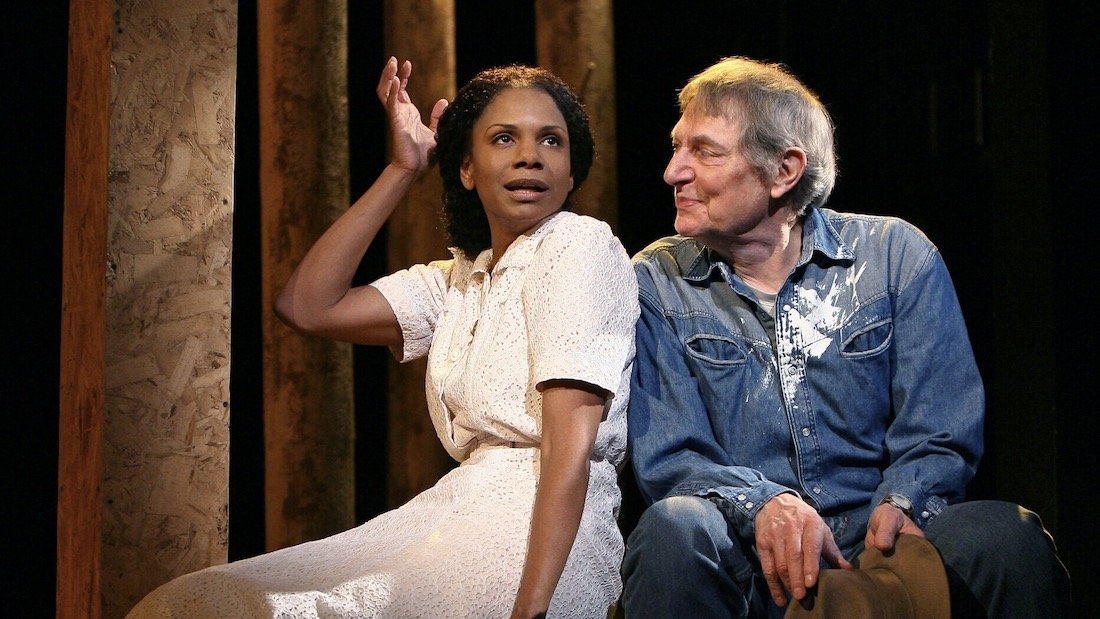
Plays that Inspired Musicals

QUIZ: Which Character from The Lightning Thief Are You?
